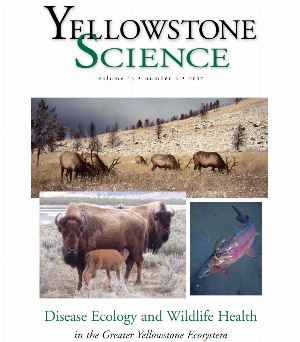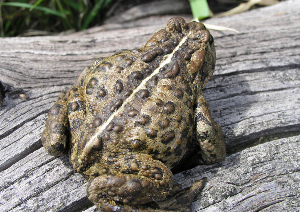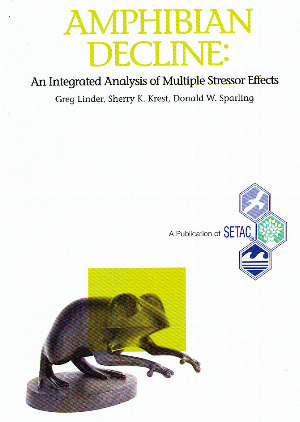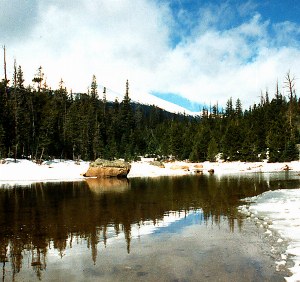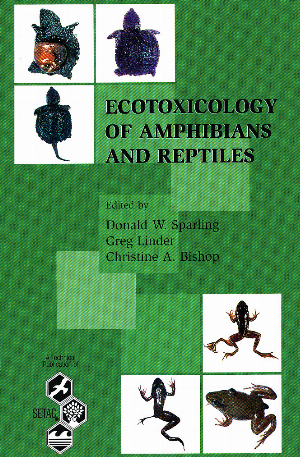Search ARMI Database
Search term(s)
Contribution Number
Search Results
856 record(s) found.
Papers & Reports Amphibians and disease: implications for conservation in the Greater Yellowstone Ecosystem
Authors: P. Stephen Corn
Date: 2007 | Outlet: Yellowstone Science 15(2): 11–16
Habitat degradation or loss, predation by alien species, over-exploitation, climate change, pollution, emerging infectious diseases, and complex interactions among two or more factors are demonstrated or hypothesized causes of amphibian declines. Here, I review the role disease may play in amphibian declines in the GYE, but note that other causes have been identified and may be as important as or more important than disease.
Papers & Reports Climate change and amphibians
Authors: P. Stephen Corn
Date: 2005 | Outlet: Animal Biodiversity and Conservation 28: 59–67
Amphibian life histories are exceedingly sensitive to temperature and precipitation, and there is good evidence that recent climate change has already resulted in a shift to breeding earlier in the year for some species. There are also suggestions that the recent increase in the occurrence of El Niño events has caused declines of anurans in Central America and is linked to elevated mortality of amphibian embryos in the northwestern United States. However, evidence linking amphibian declines in Central America to climate relies solely on correlations, and the mechanisms underlying the declines are not understood. Connections between embryo mortality and declines in abundance have not been demonstrated. Analyses of existing data have generally failed to find a link between climate and amphibian declines. It is likely, however, that future climate change will cause further declines of some amphibian species. Reduced soil moisture could reduce prey species and eliminate habitat. Reduced snowfall and increased summer evaporation could have dramatic effects on the duration or occurrence of seasonal wetlands, which are primary habitat for many species of amphibians. Climate change may be a relatively minor cause of current amphibian declines, but it may be the biggest future challenge to the persistence of many species.
Papers & Reports Endangered toads in the Rockies
Authors: P. Stephen Corn
Date: 2003 | Outlet: Taylor L, Martin K, Hik D, Ryall A, editors. Ecological and earth sciences in mountain areas. Banff, AB: The Banff Centre 43–51
The western toad species complex, endemic to western North America, includes two montane species that have undergone extensive declines. These are the Yosemite toad, Bufo canorus, in the Sierra Nevada, and the southern Rocky Mountain populations of the boreal toad, B. boreas. Most declines in the Rockies appear to have occurred before 1980, but a recent episode in Rocky Mountain National Park illustrates the rapidity and severity with which populations of toads can succumb, and that the phenomenon is still occurring. Causes of these declines with experimental or observational support include increasing ultraviolet radiation, disease, or interactions among several factors. However, significant questions about the generality of each of these hypotheses remain to be answered. Regardless of the cause of past and current declines, climate change in the coming decades may create conditions that will challenge the persistence of these species and others not currently threatened.
Papers & Reports Deteriorating status of western amphibians: can we generalize about causes?
Authors: P. Stephen Corn
Date: 2003 | Outlet: Linder G, Krest SK, Sparling DW, editors. Amphibian decline: an integrated analysis of multiple stressor effects. Pensacola, FL: Society of Environmental Toxicology and Chemistry 249–255
Regardless of whether amphibian declines are due to single or multiple causes, conservation efforts in the future will need to consider multiple stressors in most cases.
Papers & Reports Amphibian breeding and climate change: the importance of snow in the mountains
Authors: P. Stephen Corn
Date: 2003 | Outlet: Conservation Biology 17: 622–625
The breeding phenologies of ectotherms are inextricably linked to weather, and amphibians in some temperate locations may have been breeding earlier in recent years in response to warmer spring temperatures.
Papers & Reports Amphibians and wilderness
Authors: P. Stephen Corn
Date: 2001 | Outlet: International Journal of Wilderness 7(2): 25
Diversity of amphibians varies among wildernesses, from high in the Southeast to low in high-elevation Wilderness Areas and backcountry areas of National Parks in the western United States. Knowledge about the status of amphibians is important, because amphibians occupy important ecological niches and a high proportion of western amphibian species have undergone recent declines, often in protected habitats.
Papers & Reports A plague of frogs: the horrifying true story
Authors: P. Stephen Corn
Date: 2001 | Outlet: Quarterly Review of Biology 76: 64–65
Book Review - The book is written with little technical jargon and should be accessible to any biologically literate, nonprofessional reader. I also recommend this book to professional audiences, including undergraduates and early graduate students who still harbor illusions that science proceeds the way it is described in textbooks
Papers & Reports Amphibian declines: review of some current hypotheses
Authors: P. Stephen Corn
Date: 2000 | Outlet: Sparling DW, Bishop CA, Linder G, editors. Ecotoxicology of amphibians and reptiles. Pensacola FL: Society of Environmental Toxicology and Chemistry 663–696
The documented and hypothesized causes of declines in amphibian populations fall into three categories: habitat destruction and alteration. global anthropogenic influences, and natural causes. I will not review all of these in detail because some are the subjects of other chapters in this volume. I will discuss effects of introduced predators and increasing ultraviolet radiation more thoroughly because these factors represent extremes in our ability to explain and possibly reverse declines.
Papers & Reports A Technique for Detecting Eyeshine of Amphibians and Reptiles
Authors: C Corben; Gary M Fellers
Date: 2001 | Outlet: Herpetological Review 32: 89-91
Papers & Reports Estimating the abundance of mouse populations of known size: Promises and pitfalls of new methods.
Authors: P B Conn; Anthony D Arthur; Larissa L Bailey; G R Singleton
Date: 2006 | Outlet: Ecological Applications 16: 829-837
Papers & Reports Iteroparity in the variable environment of the salamander Ambystoma tigrinum.
Authors: D R Church; Larissa L Bailey; H M Wilbur; W L Kendall; J E Hines
Date: 2007 | Outlet: Ecology 88: 891-903
Papers & Reports Diet and Foraging of Rana sauteri and Bufo bankorensis Tadpoles in Subtropical Taiwanese Streams
Authors: H Chen; B Lai; Gary M Fellers; W Wang; Y C Kam
Date: 2008 | Outlet: Zoological Studies 47: 685-696
Papers & Reports Demography and movement in a relocated population of Oregon Spotted Frogs (Rana pretiosa): influence of season and gender
Authors: Nathan D Chelgren; Christopher A Pearl; Michael J Adams; Jay Bowerman
Date: 2008-12-18 | Outlet: Copeia 2008: 742-751
Translocation, repatriation and relocation of wildlife are increasingly considered as methods in the management of imperiled wildlife populations. Yet, few such efforts have been studied in sufficient detail to understand demographic responses within specific life stages. We used five years of recapture data and Bayesian estimation to assess seasonal survival, movement and growth of Oregon Spotted Frogs (Rana pretiosa) relocated into created ponds at Dilman Meadow in Oregon, USA. We evaluate hypotheses specific to the relocation and elucidate aspects of R. pretiosa life history that are poorly known. The odds of survival of relocated individuals during the first year following relocation were https://0.36 times the survival odds of relocated and non-relocated frogs after one year since the relocation. Survival rate was higher for large frogs. After accounting for frog size, we found little variation in survival between ponds at Dilman Meadow. Survival was lowest for males during the breeding/post-breeding redistribution period, suggesting a high cost of breeding for males. The highest survival rates occurred during winter for both genders, and one small spring was used heavily during winter but was used rarely during the rest of the year. Individual growth was higher in ponds that were not used for breeding, and increased with increasing pond age. Our study supports other evidence that R. pretiosa use different habitats seasonally and are specific in their overwintering habitat requirements. Because frogs were concentrated during winter, predator-free overwintering springs are likely to be of particular value for R. pretiosa populations.
Papers & Reports Hemidactylium scutatum (four-toed salamander): morphology/phenology
Authors: R J Chalmers; C S Loftin
Date: 2006 | Outlet: Herpetological Review 37: 69-71
Papers & Reports Wetland and microhabitat use by nesting four-toed salamanders in Maine
Authors: R J Chalmers; C S Loftin
Date: 2006 | Outlet: Journal of Herpetology 40: 478-485
Papers & Reports Measuring and predicting species presence – Coastal sage scrub case study
Authors: T J Case; Robert N Fisher
Date: 2001 | Outlet: Hunsaker C, Goodchild M, Friedl M, Case TJ, editors. Spatial uncertainty in ecology – Implications for remote sensing and GIS applications. New York, Springer-Verlag 47-71
Papers & Reports Taricha torosa torosa (Coast Range Newt) – Overwintering larvae
Authors: S L Carroll; Edward L Ervin; Robert N Fisher
Date: 2005 | Outlet: Herpetological Review 36: 297
Papers & Reports Conservation genetics of the endangered Shenandoah salamander (Plethodon shenandoah, Plethodontidae).
Authors: D W Carpenter; R E Jung; J W Sites
Date: 2001 | Outlet: Animal Conservation 4: 111-119
Papers & Reports Factors limiting the recovery of boreal toads (Bufo b. boreas)
Authors: C Carey; P. Stephen Corn; M S Jones; L J Livo; Erin Muths; C W Loeffler
Date: 2005 | Outlet: Lannoo M, editor. Amphibian declines: the conservation status of United States species. Berkeley: University of California Press 222–236
Book chapter that discusses specific limitations to the recovery of boreal toads from population declines in Colorado.
Papers & Reports Impacts of weathered tire debris on the development of Rana sylvatica larvae
Authors: K M Camponelli; R E Casey; J W Snodgrass; S M Lev; E R Landa
Date: 2009 | Outlet: Chemosphere 75(5): 717-722

